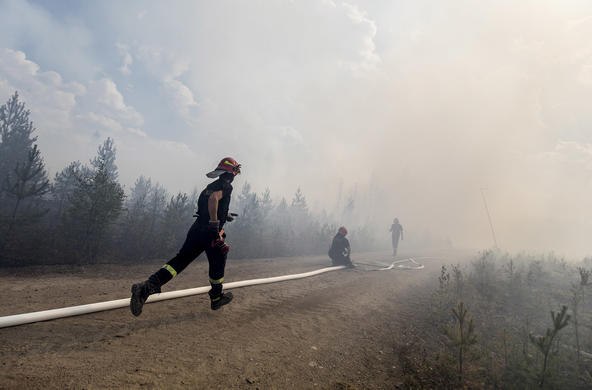Each day we breathe more than 10 cubic meters of air – more if we are exercising – so it stands to reason that stuff in the air can enter our body in large quantities. One of the pollutants of current focus is fine particulate matter, expressed in micrograms per cubic meter. The US Environmental Protection Agency (EPA) recommends that healthy air have less than 12 μg/m3 of fine particles, known as PM2.5. Despite these guidelines, many cities have more than 100 μg/m3 of fine particles, as it is often produced by combustion of fossil fuels. Rural areas can have as little as 1 μg/m3.
We’ve known for some time that breathing air polluted with fine particles increases human mortality. Most of the focus has been on respiratory ailments – asthma, emphysema, and pneumonia, but heart disease and stroke are also associated with airborne fine particles. Now, a new study suggests that breathing fine particles can affect other facets of human health, namely the severity of neurodegenerative diseases such as Alzheimer’s disease, Parkinson’s disease, and other forms of dementia. The incidence of these diseases now amounts to more than 50,000,000 cases per year, with estimates tripling by the year 2050, as the population ages. Dementia is a terrible way to go.
The new work, by researchers in the Medical Schools at the University of Minnesota and Duke University, focused on different regions in North Carolina, and found surprising increases in the mortality rates from dementia with increasing levels of air-borne particles. Even though all counties in North Carolina report that air quality meets the US EPA guidelines, certain parts of the state exceed guidelines of the World Health Organization. This disparity in air quality in North Carolina set the stage for the natural experiment comparing the populations of individuals living in air containing more than 10 μg/m3 PM2.5, to populations living with air with much less pollution. The study compared hospitalizations, emergency room visits, and death from dementia in large populations. The groups were well matched in other characteristics – but the collected data allowed the researchers to account for differences in race, age, gender, and quality of health care. Greater impact of particulate air pollution was seen for Caucasian than for African American citizens, but all were affected.
Particulate air pollution comes from two sources. Some particles, known as primary aerosols, are emitted directly from human activities, such as coal-fired power plants, motor vehicles, road dust, and wood smoke. Not surprisingly, the abundance of primary aerosols decreased during the partial economic lockdown for the COVID virus.
Other particles, known as secondary aerosols, form in the atmosphere by reactions between gases. For instance, ammonia gas from hog farms can react with sulfuric and nitric acid vapor to form an ammonium aerosol particle.
The characteristics of airborne particles can vary enormously. Some contain metals such as vanadium, mercury, or arsenic. Others contain a variety of organic compounds. The impact of these characteristics deserves further study; in the North Carolina study, higher levels of arsenic were found in areas with higher levels of particulate air pollution.
The link between air pollution, air-borne particles, higher mortality, and specific diseases is now complete. For better health for everyone, we should heed efforts by the Environmental Protection Agency to curb air pollution.
Reference
Rhew, S.H., J. Kravchenko, and H. K. Lyerly. 2021. Exposure to low-dose ambient fine particulate matter PM2.5 and Alzheimer’s disease, non-Alzheimer’s dementia and Parkinson’s disease in North Carolina. PLOS One pone.0253253






